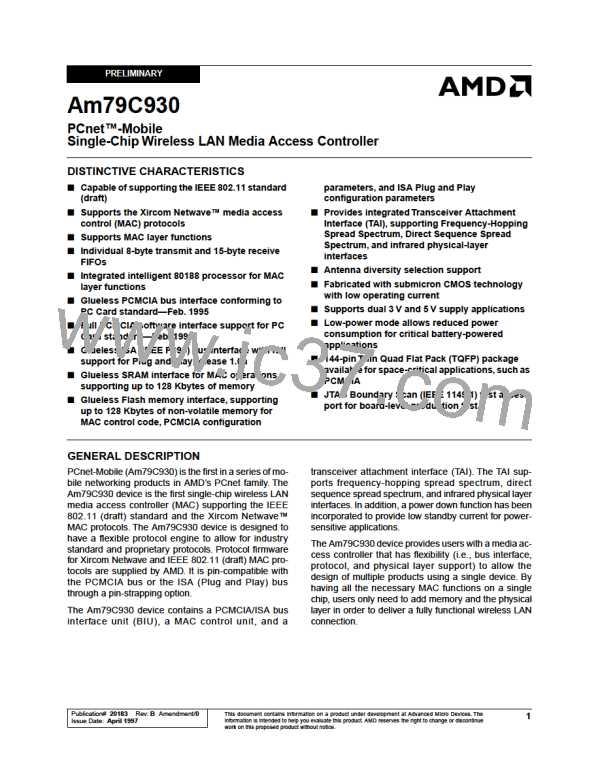AMD
P R E L I M I N A R Y
resolution is equal to twice the CLKIN period when the
CLKGT20 bit of MIR9 is set to 1. (For a 1 MB data rate
with CLKIN = 20 MHz and CLKGT20 = 0, resolution is
50 ns.) After each pair of rising edges is detected, the
value of the rising edge separation counter is compared
against the Baud Detect upper limit register value
(TCR17) and also against the Baud Detect lower limit
register value (TCR18). If the rising edge counter value
is between these limits, then a GOOD counter is incre-
mented. If the rising edge counter value is outside of
these limits, then a FAIL counter is incremented.
count exceeds this value, then the Baud Detect determi-
nation for Stop Diversity is TRUE. The Baud Detect de-
termination for Stop Diversity may in turn, be used in the
final determination of antenna selection, depending
upon the setting of the UBDSD bit of TCR28.
Clear Channel Assessment Logic
The Am79C930 device gathers CCA information from
one of two possible sources. One source is the
Am79C930 device’s internal CCA logic, which is de-
scribed in the following paragraphs. The other possible
CCA source is externally computed CCA information,
whichisthenpassedintotheAm79C930devicethrough
the USER5/IRQ4/EXTCHBSY pin. Regardless of the
source of CCA information, a path through the
Am79C930 TAI section is provided allowing the embed-
ded 80188 controller to either poll the status of the CCA
result or to be interrupted by any change to the CCA
status, or to be interrupted whenever the CCA status
changes to the “Busy” state. Selection of CCA source is
through the ENXCHBSY bit of TCR15.
A similar comparison is made whenever the falling edge
detection circuit locates a pair of falling edges. The
GOOD counter and the FAIL counter are shared by both
the rising edge and falling edge measurement circuits.
Both rising edge measurements and falling edge meas-
urements will contribute to the total GOOD and FAIL
counts during any Baud Determination cycle period.
Note that the falling and rising edge separation counters
begin counting at 0 and count up to 30 decimal and then
wrap back to 10 decimal before continuing. This means
that all multiples of 20 counts are aliased to a final
counter indication of 20. Neither of the rising or falling
edge separation counters is accessible to the user.
The TAI contains CCA logic that relies on two inputs to
determine whether or not a carrier is present on the me-
dium. One, both, or none of the two inputs may be se-
lected to determine whether or not a carrier is present.
Oneinputthatmaybeusedtodeterminecarriersenseis
the result of the Baud Determination of Carrier Sense as
described in the Baud Determination logic section. The
other input used by the CCA logic is whether or not the
value of the converted RSSI input exceeds a pro-
grammed lower limit (RSSI Lower Limit of TIR28).
At the end of any Baud Determination cycle, the value in
the GOOD counter is compared against the Baud De-
tect Accept Count for Carrier Sense (TCR19). If the
GOOD count is less than the value of TCR19, then the
Baud Detect determination of Carrier Sense is uncondi-
tionally FALSE. If the GOOD count exceeds the value of
TCR19, then the GOOD count is compared against the
value of the Baud Detect Ratio register (TCR21) multi-
plied by the FAIL count. If the GOOD count exceeds this
value, then the Baud Detect determination of Carrier
Sense is TRUE. The Baud Detect determination of Car-
rier Sense may, in turn, be used in the final determina-
tion of Carrier Sense (Clear Channel Assessment),
depending upon the setting of the UBDCS bit of TCR28.
Note that Baud Determination of Carrier Sense meas-
urements are made on a periodic basis where the period
and duty cycle of the measurements depends upon the
settings of the Antenna Diversity Timer (TCR4) and the
Baud Detect Start timer (TCR16).
EitherinputorbothinputsmaybeusedtomaketheCCA
decision. Each input to the CCA logic is enabled by a
specific bit of TCR28. The UBDCS bit of TCR28 is used
to select/deselect the Baud Determination of Carrier
Sense for use in CCA decisions, and the URSSI bit of
TCR28 is used to select/deselect RSSI information in
CCA decisions. Note that URSSI bit of TCR28 is also
used to select/deselect RSSI information for use in Stop
Diversity decisions.
At the end of any Baud Determination cycle, the value in
the GOOD counter is compared against the Baud De-
tect Accept Count for Stop Diversity (TCR20). If the
GOOD count is less than the value of TCR20, then the
Baud Detect determination for Stop Diversity Switching
is unconditionally FALSE. If the GOOD count exceeds
the value of TCR20, then the GOOD count is compared
against the value of the Baud Detect Ratio register
(TCR21) multiplied by the FAIL count. If the GOOD
The possible CCA results are as follows.
Am79C930
53

 AMD [ AMD ]
AMD [ AMD ]